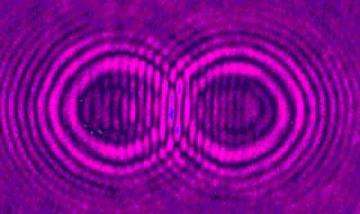Laser experiments reveal strange properties of superfluids

Princeton University electrical engineers are using lasers to shed light on the behavior of superfluids -- strange, frictionless liquids that are difficult to create and study. Their technique allows them to simulate experiments that are difficult or impossible to conduct with superfluids.
The odd behavior of particles in superfluids, which move together instead of at random, has been observed in light waves that pass through certain materials known as nonlinear crystals. The team relied on this underappreciated correlation to use laser light as a substitute, or model, for superfluids in experiments. Their results will be published in the January 2007 issue of Nature Physics.
Their work could heighten the current understanding of condensed matter physics as well as lead to advances in sensor technology, atomic trapping and optical communications.
"Once you realize you can use light to model a superfluid, a new world opens up," said Jason Fleischer, a Princeton assistant professor of electrical engineering who led the team. "An entire field of physics is interested in studying the dynamics of superfluids, but the experiments are difficult to do. It's a lot easier to conduct the experiments with lasers."
Fleischer and Princeton Engineering graduate students Wenjie Wan and Shu Jia validated their technique by generating results that matched data from previous superfluid experiments. They went on to study superfluid waves and interactions that had not been considered before, either theoretically or experimentally. For instance, they explored the collisions of circular waves similar to those created by drops of water falling into a puddle.
"Shock waves are an example of a bigger picture idea," Fleischer said. He plans to explore other superfluid phenomena in future optical experiments.
Citation: Wan, Jia and Fleischer. Dispersive, superfluid-like shock waves in nonlinear optics. Nature Physics. January 2007. doi: 10.1038/nphys486.
Source: Princeton University





















